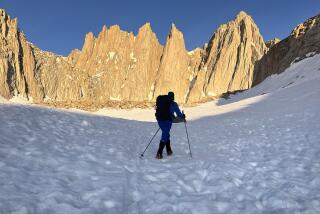McKinley Expedition Backs Early Climber’s Claim : Exploration: His peers scoffed at Dr. Frederick Cook’s claim to be first to reach Mt. McKinley’s summit. But climbers who recently retraced his path say it looks as if he made it after all.
- Share via
SEATTLE — In the early 1900s, Dr. Frederick Cook claimed to be the first person to reach the summit of Mt. McKinley and the first to reach the North Pole. His peers laughed and called him a fraud.
But a group of mountain climbers who recently retraced Cook’s Mt. McKinley path say they found proof he got closer to the top of the 20,300-foot Alaska peak, North America’s highest, than most historians have allowed.
Although there’s probably no way to prove or disprove that Cook made it all the way, the climbers say they’re confident at least some of the mudslinging he endured to his deathbed was unjust.
“I think what we did is reopen a closed book,” said Scott Fischer of Seattle, a member of the eight-member team that returned from Alaska recently.
“I hate to call anybody a liar. The guy’s been called a liar and we don’t know that. Now there’s some pretty good evidence that maybe he wasn’t,” he said.
Cook, a physician who was an outstanding Arctic and Antarctic explorer in his time, said he scaled the summit in 1906. His problems started three years later, when he returned from an Arctic expedition and said he reached the North Pole in April, 1908.
Robert E. Peary, a Navy civil engineer, returned from the Arctic a few days after Cook did. He also reported reaching the North Pole.
The debate over who was the first to discover the pole resulted in a smear campaign. Cook historians say Peary attacked Cook’s McKinley claim as a way to discredit his North Pole claim. And there’s evidence Peary’s camp paid $5,000 for an affidavit from Cook’s McKinley climbing partner, Ed Barill, to discredit Cook’s story.
Cook was eventually expelled from the influential Explorers Club, of which he was once president, for perpetrating fraud, according to news accounts.
Today, most historians and mountaineers credit Archdeacon Hudson Stuck and his party as the first ones to reach Mt. McKinley’s summit, in 1913.
Using Cook’s 1906 diary and sketches, along with other recent finds, the modern-day team set out to put the Cook controversy to rest. The expedition, led by Seattle polar historian and mountaineer Ted Heckathorn, was funded in part by a grant from the Frederick A. Cook Society of Hurleyville, N.Y.
Three climbers--Fischer, Doug Nixon of Oak Harbor, Wash., and Vern Tejas of Anchorage--scaled a ridge at approximately 11,500 feet. What they saw and took photos of from there matched Cook’s descriptions and sketches perfectly, they said.
Their findings would have put Cook within 10 miles of route distance from McKinley’s summit. Most of the evidence presented against him is that he never got above 6,000 feet or within 20 miles route distance from the summit.
“I’m following what this guy wrote and the pictures he drew and I matched him,” Fischer said. “From the same spot, he says he sees a ridge that goes to the summit. I’m standing on a ridge that goes to the summit.”
“I think there is a good possibility he reached (the top) and we certainly demolished the evidence against him,” Heckathorn said.
Cook’s personal papers indicate he left behind a brass tube under some rocks just below the summit. Organizing an expedition to find it might be a logical next step, but there will always be detractors no matter what is found, Heckathorn said.
More to Read
Sign up for Essential California
The most important California stories and recommendations in your inbox every morning.
You may occasionally receive promotional content from the Los Angeles Times.













